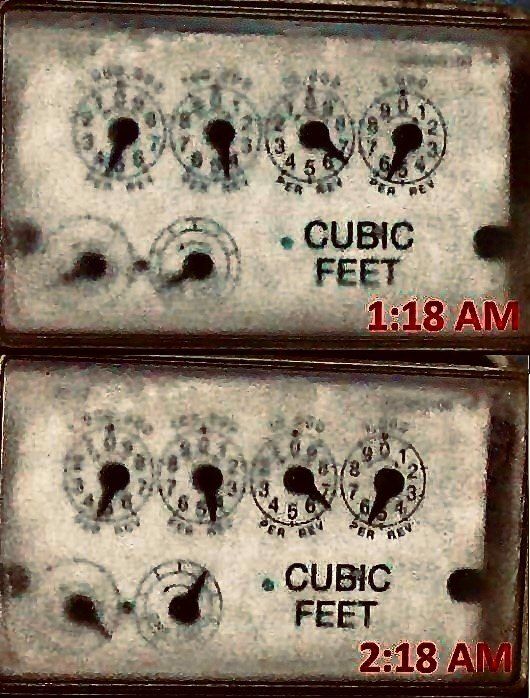Published Saturday January 19, 2013: Updated 10/30/2021
Water Heater Pilot Light Energy Consumption
How much energy does the pilot light consume?
I was curious how much energy the pilot light on the water heater consumes.
So as to not contaminate the measurement, I turned off the the furnace and shut off the fireplace pilot light during this time so only the pilot light on the water heater would be running. I also waited until late at night so nobody else in the house would accidentally use hot water and cause the water heater burner to kick on.
At 1:18 AM, I took a picture of my gas meter.
Exactly 1 hour later, I took another picture of the gas meter.
The meter gets sprayed by sprinklers and baked by the sun in the evening, so the dials are kind of hard to read. Also it doesn't help that these pictures were taken in the middle of the night. I tweaked the contrast in these pictures a bit so the dials and tick marks show up better.

Looking from left to right, the lower two dials are 1/2 cubic foot and 2 cubic feet. Each segment on these dials is 1/10th of a turn.
The 2 cubic foot dial moved counterclockwise almost 6/10ths of a turn. Let's call it 0.58 turns.
0.58 turns x 2 ft^3 per turn = 1.16 cubic feet of gas. Again, the only gas appliance that was running this whole time was the pilot light on the water heater.
If the pilot light consumes 1.16 cubic feet of gas every hour, in 30 days time, the pilot light alone will burn through (1.16 ft^3 x 24 hours x 30 days) = 835.2 cubic feet of natural gas.
See the table below for the pilot light energy consumption over various time frames and displayed in different energy units.
Natural Gas Water Heater Pilot Light Energy Consumption Over Time
| Energy Unit | Per Hour | Per Day | Per 30 Days | Per Year |
|---|---|---|---|---|
| ft^3 | 1.16 | 27.84 | 835.20 | 10161.60 |
| Therms | 0.0116 | 0.2784 | 8.35 | 101.62 |
| BTU | 1160 | 27840 | 835200 | 10161600 |
| kWh | 0.33998 | 8.16 | 244.78 | 2978.19 |
| Watts (Continuous) | 340 watts |
340 watts is a ridiculous amount of stand-by power. Over time that leads to an enormous energy loss. While you could argue that some of this energy is going towards heating up the water in the tank, much of it is traveling right up the flue and being wasted.
